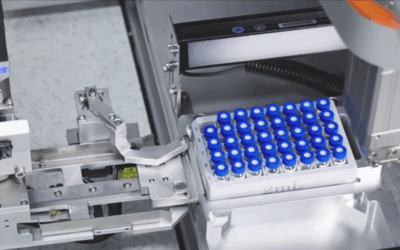The endocrine system comprises myriad glands, hormones and receptors throughout the body that regulate biological processes from birth to death. Chief among those processes is the differentiation, growth and function of the human reproductive system.
Human epidemiology research suggests that environmental contaminants may interfere with the endocrine system, leading to adverse health effects. Specifically, pesticides, food additives, active pharmaceutical ingredients (APIs) and other substances appear to cause developmental and reproductive toxicity (DART) by disrupting the endocrine system, but direct evidence of this causal relationship is limited.
In fact, very few chemicals have been tested because most of the current methodologies fail to provide adequate data to identify endocrine disruptors (EDs) and assess human risk. However, exposure to EDs can lead to developmental malformations, reproductive interference and immune/nervous system dysfunction. General toxicity can also contribute to mutagenicity and carcinogenicity, so these data must also be included in reproductive risk assessments.
DART testing can provide important information about exposure dose, duration, timing, and route of administration for countless chemicals. Not to mention, regulatory agencies worldwide expect to see this data when assessing a substance’s safety. No current DART test method can fully account for the number and complexity of endpoints involved, but the U.S. Environmental Protection Agency (EPA) created a two-tiered system to begin differentiating between substances that pose no risk and those that have potential to do so.
The EPA’s Two-Tiered Screening System
The EPA launched the Endocrine Disruptor Screening Program (EDSP) in 2015 to identify a group of screening assays that will generate the most valuable DART data for various chemicals. The agency issued testing orders for 67 pesticide chemicals that had the potential to interact with and disrupt the endocrine system. Of the original 67, 15 chemicals were subsequently canceled or discontinued, leaving 52 test candidates.
The EPA’s Tier 1 methodology included 11 screening assays—five in vitro; six in vivo—in addition to general toxicity data and open literature studies. When taken together, these data can satisfactorily determine which chemicals have the greatest potential for endocrine bioactivity. Specifically, Tier 1 screening can identify chemicals that may adversely interact with the estrogen, androgen or thyroid hormonal systems and thus require in-depth testing.
EDSP guidelines were created to meet the requirements of the Toxic Substances Control Act (TSCA), the Federal Insecticide, Fungicide, and Rodenticide Act (FIFRA), and the Federal Food, Drug & Cosmetic Act (FFDCA). Assays needed to satisfy Tier 1 requirements include:
- Amphibian Metamorphosis (Frog)
- Androgen Receptor Binding (Rat Prostate)
- Aromatase (Human Recombinant)
- Estrogen Receptor Binding
- Estrogen Receptor Transcriptional Activation (Human Cell Line HeLa-9903)
- Fish Short-Term Reproduction
- Hershberger (Rat)
- Female Pubertal (Rat)
- Male Pubertal (Rat)
- Steroidogenesis (Human Cell Line – H295R)
- Uterotrophic (Rat)
Of the 52 chemicals tested, 20 showed no evidence for potential interaction. Fourteen of them showed potential for endocrine disruption, but the EPA already had information determining that they posed no risk. That left 18 chemicals. All of them showed the potential to interact with the thyroid pathway, 17 would potentially interact with the androgen pathway, and 14 with the estrogen pathway.
Despite these findings, the EPA reiterated that results indicating potential for interaction should not be construed as a conclusion that the chemical is an ED. However, it does mean those chemicals require more testing, and are thus entered into the agency’s second tier. Tier 2 assays include:
- Avian Two-Generation Toxicity Test in the Japanese Quail (4 chemicals)
- Medaka Extended One Generation Reproduction Test (13 chemicals)
- Larval Amphibian Growth and Development Assay (LAGDA) (5 chemicals)
In Europe, the Organization for Economic Cooperation and Development (OECD) governs chemical testing. While the OECD is a collection of internationally agreed-upon testing methods, it generally adheres to the EPA screening assay guidelines stated above. It also requires additional testing to evaluate chemical safety, including:
- Reproductive/Developmental Toxicity Screening Assay
- Prenatal Developmental Toxicity Test
- Two-generation Reproduction Toxicity Study
- Extended One-generation Reproductive Toxicity Study
The EPA’s Risk Assessment Approach
The EPA’s risk assessment guidelines include hazard characterization, quantitative dose-response analysis, exposure assessment, and risk characterization. Characterizing a hazard for reproductive toxicity must also include “all available experimental animal and human data” pertaining to dose, route, timing and duration of exposure. Dose response relationships are often the best way to characterize a substance’s hazard level. Exposure assessments also provide valuable information on the type, frequency, magnitude and duration for each substance. To derive the necessary data, the EPA’s reproductive toxicity risk assessment is based on five default assumptions:
- A substance producing an adverse reproductive effect in laboratory animals is assumed to pose a potential threat to humans.
- Xenobiotic effects on male and female reproductive processes are assumed to be similar unless demonstrated otherwise. For developmental outcomes, the specific effects in humans are not necessarily the same as those seen in the experimental species.
- In the absence of information to determine the most appropriate experimental species, data from the most sensitive species should be used.
- In the absence of information to the contrary, an agent that affects reproductive function in one sex is assumed to adversely affect reproductive function in the other sex.
- A nonlinear dose-response curve is assumed for reproductive toxicity.
At present, the following chemicals have been identified as requiring additional Tier 2 testing. Having any of these chemicals in your facility requires submitting to the EPA a Hazardous Chemical Inventory form. Different states require different information, but all documentation should include the location(s) and amount(s) of potentially hazardous chemicals presently and throughout the entire previous calendar year.
| Chemical | Human Health | Wildlife |
| Carbaryl | None | MEOGRT |
| Chlorothalonil | None | LAGDA |
| Cypermethrin | Special study: Assess androgen-related effects in adult males | MEOGRT |
| DCPA | CTA (comparative thyroid assay) | LAGDA |
| Dichlobenil | None | MEORGT |
| Dimethoate | CTA | None |
| Flutolanil | None | MEOGRT |
| Folpet | None | MEOGRT |
| Iprodione | None | MEOGRT |
| Linuron | CTA | MEOGRT, LAGDA |
| Metalaxyl | None | MEOGRT |
| Metribuzin | CTA | LAGDA |
| Myclobutanil | None | MEOGRT |
| O-phenylphenol | None | MEOGRT |
| PCNB | None | MEOGRT |
| Propargite | None | LAGDA |
| Propiconazole | None | MEOGRT |
| Tebuconazole | None | MEOGRT |
A Final Word
Assessing risk requires scientific judgment concerning the potential for harm to human beings. But “harm” can be subjective and “risk” relies on qualitative socioeconomic and political measures like margin of exposure (MOE). When it comes to reproductive health, the conversation becomes more difficult because so little is known about endocrine disruption. Regulators worldwide have been trying to understand and prevent endocrine interference since the 1930s, but drug developers and sponsors unfamiliar with recent guidance would do well to work with an experienced and knowledgeable testing partner.
Talk to a WuXi AppTec expert today to get the support you need to achieve your drug development goals.
As a global company with operations across Asia, Europe, and North America, WuXi AppTec provides a broad portfolio of R&D and manufacturing services that enable the global pharmaceutical and life sciences industry to advance discoveries and deliver groundbreaking treatments to patients. Through its unique business models, WuXi AppTec’s integrated, end-to-end services include chemistry drug CRDMO (Contract Research, Development and Manufacturing Organization), biology discovery, preclinical testing and clinical research services, helping customers improve the productivity of advancing healthcare products through cost-effective and efficient solutions. WuXi AppTec received an AA ESG rating from MSCI for the fourth consecutive year in 2024 and its open-access platform is enabling around 6,000 customers from over 30 countries to improve the health of those in need – and to realize the vision that “every drug can be made and every disease can be treated.”


